azu_td_1349475_sip1_... - Arizona Campus Repository
azu_td_1349475_sip1_... - Arizona Campus Repository
azu_td_1349475_sip1_... - Arizona Campus Repository
You also want an ePaper? Increase the reach of your titles
YUMPU automatically turns print PDFs into web optimized ePapers that Google loves.
37<br />
four level approximation. As the number of quantized steps, N, increases, the<br />
lens more closely approximates the continuous kinoform phase profile and the<br />
diffraction efficiency of the element will approach 100%.<br />
As will be discussed in more detail later, a multilevel diffractive lens is<br />
fabricated using a set of binary masks. Each mask produces two phase levels.<br />
Thus, M masks are needed to produce 2 M = N phase levels. A two step (N=2)<br />
binary lens therefore only requires a single mask, a four level element (N=4)<br />
requires two masks and similarly for N=M.<br />
The transition points for the boundaries of each zone in a multilevel<br />
element are calculated by examining the phase function given by Equation 3.4.<br />
For the case of the binary lens already discussed, the zone boundaries were<br />
determined by setting Equation 3.4 equal to multiples of n to satisfy the zone<br />
theory of Fresnel. It can be seen from Figure 3.7 that the size of these zone<br />
boundaries decreases as the number of levels increases. With each<br />
successive mask, the zone widths decrease by a factor of two, and two more<br />
phase levels are added. Since every mask produces 2 phase levels, the<br />
boundary of each zone occurs when the phase function in Equation 3.4 equals<br />
7c/M. Equivalently this may be expressed as<br />
3.8<br />
Solving Equation 3.8 for r m and m as before gives the boundary for each zone<br />
and the maximum number of zones created by M masks,
















